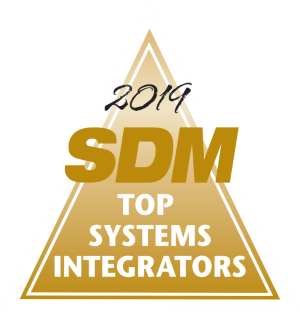The primary thing for security integrators to know about today’s video management systems (VMS) can be summed up in just a few words: these solutions are no longer commodities, but have evolved into fully functional business and security management hubs.
Understanding this is one thing, but putting it into practice is another, requiring a significant shift in thinking away from the security-only focus on the “video” in VMS; integrators today have to understand how solutions, including access control, visitor management, identity management, video and more, work together as parts of a larger system — and how to use VMS to leverage these integrations and provide their customers with a video-plus system that meets their needs.
“(Integrators) need to look beyond the technology to see how the end user is living with it,” says Kami Dukes, director of business development for AMAG Technology, Torrance, Calif. “How are they using it? What are they using it for? Do they understand how they can use the video? How is video tied into their incident and case management? In addition, integrators must know their customer’s technology roadmap for the next three to five years to provide the video solution that makes the most sense.”
The VMS solutions of today are cost-effective solutions designed to provide end users with the flexibility to customize their systems to integrate their customers’ choice of cameras, storage and other technologies to meet their specific needs. Most importantly, security integrators want these technologies to play well together from the get-go, says Grant Cowan, director of national accounts for Austin, Texas-based Salient Systems.
“What integrators are looking for at the end of the day is the right solution right out of the gate the first time,” he says. “With a custom application, they need to get it right the first time or they’re going to spend hours and hours trying to make it right, and they’re going to end up losing money.”
COST VERSUS VALUE
As with any technology, the biggest hurdle integrators must overcome in the sales process is the cost of the solution. With VMS, this includes expenses related to the initial investment and ongoing maintenance, as well as camera licensing fees.
“End users need to understand, up-front, the recurring costs associated with keeping their software current and/or maintaining camera licenses,” says Bret McGowan, senior vice president, sales and marketing, Vicon Industries, Hauppauge, N.Y. “Therefore, integrators supporting these customers need to understand how the manufacturer has structured those costs. Integrators who can keep their customers’ systems current and running optimally, with minimal recurring costs, will have a happier, more loyal clientele.”
Shifting the conversation from the cost to the value of VMS solutions is important for integrators.
“Today’s best security integrators will educate their customers to view their purchase of a VMS as an investment, more than an expense,” says Andrew Elvish, vice president, marketing and product management, for Montreal-based Genetec. “Although traditionally a VMS is used for security applications, an adaptable VMS can serve multiple departments within an organization, making the VMS not only multi-purpose, but potentially turning it into a revenue-generating or cost-cutting tool.”
Advanced video analytics are playing a major role in this shift. Having gained prominence in safety and liability applications, such as tripwires and left-object detection, analytics are increasingly being leveraged for non-security purposes, such as business and marketing intelligence. This trend will have an enormous impact on VMS, says Steve Birkmeier, vice president at St. Louis-based Arteco.
“These types of marketing-support platforms support intelligence gathering from a single location to hundreds of stores, delivering a comprehensive view of marketing efforts across an organization’s infrastructure,” he says. “People-counting, heat-mapping, biometrics and other advanced video analytics help users identify key data points, manage resources and optimize marketing campaigns to increase revenue.”
INTUITIVENESS & EASE OF USE
Regardless of technologies, capabilities or integrations, VMS that are complicated to deploy, time-consuming to maintain and difficult for end users to understand are doomed to fall short of promises and expectations, McGowan says. “(They) will not be embraced as completely or used as effectively as a system that delivers a simplified, streamlined experience,” he says.
Unfortunately, McGowan adds, many providers have that backwards. “In many cases, system manufacturers are focusing on engineering ‘wow’ factors at the expense of a hassle-free, positive user experience,” he says.
One constant that every security user wants is for their surveillance system to be intuitive, Birkmeier says.
“After all, what good does it do to collect all of this video data if the people responsible for overseeing the system can’t easily retrieve it?” he says. “Despite the emergence of the Internet of Things and the connected world in which we live today, there are an astonishing number of security personnel who, at this very moment, are spending an inordinate amount of time either trying to find the important footage needed to investigate or close a case, or figuring out how to get it where it needs to go.
“Today’s modern systems integrators need to know how to help their customers navigate solutions to this challenge,” Birkmeier adds.
THE IT FACTOR
Based on price and margin pressures, the investment in higher-end, IT-savvy engineers is often overlooked in favor of sending a technician for technical training on a particular VMS, says Mike Sherwood, director of technical services, Milestone Systems, Copenhagen.
However, as projects become more complex with more sophisticated network or storage requirements, the skillset needed for successful implementation and ongoing end user support is much higher than they can possibly learn in these classes. This challenge will only be compounded as additional products are added to the mix, requiring integration with the VMS.
“There is an IT experience element that is the best fit,” Sherwood says. “Although these are costly positions to fill in an integrator’s company, it is well worth it because it will reduce the overall engineering time required to reach a successful outcome. In time, this has the potential to degrade the overall customer experience, not to mention reduce long-term business for the integrators with problematic installations.”
Because of this tendency to cut staffing costs, manufacturers are seeing increases in demand for support for complex cases. Cowan says manufacturers can reduce this trend by ensuring they offer strong integrations with a variety of products.
“When we work with our manufacturing partners, we’re looking for deep integrations … we’re not looking to do just a basic integration to put a check in the box,” he says. “When working with a VMS, how deep are the integrations? Do they offer an end-to-end solution with their product partners? Where are they in the whole roadmap with that particular provider?”
Still, says Ken LaMarca, vice president of sales and marketing for Pearl River, N.J.-based OnSSI, there is no substitute for strong manufacturer support, particularly given the speed with which innovation and technology advancements arrive in the security industry.
“In addition to phone, Web and other more traditional support options, some VMS companies will team with integrators to host interactive training sessions that encourage conversation, communication and collaboration,” he says. “In many cases, this will take place at the integrator’s location, eliminating the time and travel expense of sending their staff off-site. For security professionals, the value of these and other support opportunities cannot be overstated.”
To truly assess at the state of VMS both today and into the future requires looking at three distinct tiers of solutions: free software for small systems; basic appliances offering some investigative tools and basic integrations for the mid-tier market; and highly scalable or federated server-based solutions for enterprises, says Jammy DeSousa, senior product manager, American Dynamics brand, for Westford, Mass.-based Tyco Security Products. The lower end of the market is being driven by apps to address users’ expectations for mobile and ease of use, he says, while the enterprise market will continue to drive custom integrations.
But the most dynamic segment, DeSousa says, will be the middle market.
“We expect to see the most dramatic changes over the next 12 to 24 months in the mid-tier market, where cloud services will evolve to service this market,” he says. “This space will continue to see more and more third-party integrations that extend the functionality of the VMS platform for intrusion, fire and some vertical market integrations.”
While security will always be a main function of VMS, it could become less of a factor in end users’ evaluation of solutions in the future, Birkmeier says.
“Not only are today’s end users more tech-savvy than ever before, but they seek out ways to gain more data and more intelligence from their video data,” he says. “Moving forward, video management systems are going to be judged based on how quickly and easily they can aggregate video for users within this new big data landscape.”
Protecting the Network
The networked nature of our world has brought cybersecurity to the forefront, with each large-scale, well-publicized network breach bringing this need farther into the forefront. Given their heavy reliance on networks to be effective, VMS must also incorporate strong cybersecurity measures. This has become a top priority for integrators, says Genetec’s Andrew Elvish.
“Today’s integrators will ensure that their clients make sure their VMS is a wall against intruders, and cannot become a gateway for cyber intruders to access sensitive video and sensitive financial information,” he says. “Finally, integrators will define a security strategy that ensures their customer’s VMS meets the most up-to-date ‘Security of Security’ requirements, with no exceptions.”
Among the easiest network entry points for hackers and cybercriminals to exploit are software vulnerabilities, and VMS are by all means not immune to this potential, says OnSSI’s Ken LaMarca. Recognizing this, VMS companies constantly strive to close these open doors with security patches, which are delivered in regular updates. The unfortunate reality, he adds, is that these updates far too often go uninstalled.
“As a result, hackers continue to be successful at identifying and exploiting this low-hanging fruit,” LaMarca says. “Keeping VMS software current is vital to security, but patches and updates are irrelevant if they are not installed regularly. Integrators can assure their customers that they will always be running the most current and secure version of their VMS.”
Additional cybersecurity measures included in advanced VMS include end-to-end AES encryption between clients and recorders for video data security, as well as randomized video databases that reduce the risk of unauthorized data manipulation, La Marca adds.
“By deploying VMS with end-to-end encryption, integrators can save customers substantial time and money, while also saving themselves the cost and inconvenience of adding third-party encryption software to complement the solution,” he says.
Aligning Skills & Technology
According to Mike Sherwood, director of technical services, Milestone Systems, Copenhagen, there is a lack of best practices for VMS deployments ... throughout the security industry. Instead, the success of implementations tend to rely heavily on the skills of the integrator to know how best to deploy the solution. Sherwood suggests combining the two to ensure end users get the most out of their VMS.
“I would advocate that our partners need to implement a standard core of best practices as it relates to the VMS they are implementing, and aligned with their skill set,” he says. “Implementing tools that will help with the success and speed of installation or the application of best practices will help to reduce delays and errors in deployments.”
In many cases, integrators look to manufacturers to provide these tools, but Sherwood says it is better to develop them internally, which will give them a competitive advantage. The key to this is for security professionals to focus on a core set of offerings rather than trying to provide everything for everyone.
“Instead of selling four different VMS products that they are mediocre at implementing, they should narrow down to one primary solution that they are really good at implementing. This in turn will have a positive impact on project and service contract profit margins,” Sherwood says.
MORE ONLINE
For more information on video management systems visit SDM’s website where you will find the following stories:
“Open-Platform VMS Dominates the Market of the Future”
www.SDMmag.com/open-platform-vms-dominates-the-future
“Advances in Video Analytics Build Trust and Growth”
www.SDMmag.com/advances-in-video-analytics
“Own the Store — or as Much of it as Possible”
www.SDMmag.com/own-the-store










